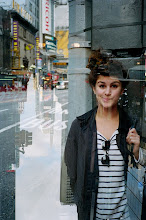Style in the Noughties- Perfection of regression?
Debbie Harry - one of many fashion icons still relevant today [Flickr, Jlacpo]When we look back on the fashion over the last decade, how many new and original trends can we boast? Not all that many come to mind.
With the new millennium came the age of recycling, which encompassed fashion as well as cereal boxes and wine bottles. A great deal of the styles we have seen through the noughties have been rehashes from eras gone past. Whether we buy from vintage or high street shops, there are at least echoes of fashion from the 20th century.
Over the past decade we have come across young people who look like replicas of 40s land girls, wearing headscarves and high waisted trousers, or what seems to be the cast of The Breakfast Club or Quadrophenia, or members of The Ramones.
Can we truly relate with punk or mod phases, or the era of the 50s housewife or moviestar? Is it because everything has been done that we have not created our own fashion identity?
Speaking to our generation's fashion students reveals more about what has happened to this century's style so far. Eliza Conlon is a Womenswear Student at Central Saint Martins and has interned as Jonathan Saunders' assistant for the last two summers.
She says that it is the 'micro trend' that develops now. Because our society has become so diverse, big trends have emerged less and less. She does, however, mention designers who have created a 'look', like Jil Saunder whose is 'minimal and clean'.
On the whole though, she does agree that fashion has hit a bit of a wall recently: "Everything has kind of been done before and it's very hard to be original and create a new sweeping trend."
Recycled
Annie Pheby, a Fashion Marketing student studying at London College of Communication and former intern of Roland Mouret, agrees that the trends of the noughties are not technically new.
What has come about though is the rise in 'youth subcultures', from which certain trends have derived: "In previous years there would have been a couple of predominant cultures, i.e. rockers and mods. Whereas these days there are a huge amount; emos, indies, metros, chavs, WAGs."
Still though, these movements are reflective of past fashion or music movements, for example 'emos' hark back to the 90s grunge trend.
A specific aspect of fashion phases is make up. According to Lucy Pearson, a student studying foundation Fashion Hair and Make Up at London College of Fashion, the most reproduced 'look' is classic 1950s.
"This look is an unbelievably huge trend, the likes of which have never before been seen in a rehash of a certain style of make up. Can you think of anyone who doesn't wear a liquid black liner over their lids or a crisp red lip?". Nevertheless, Pearson also accredits the noughties as "a time for great experimentation and change in make up trends."
Though trends and 'looks' specific to only the noughties have been rare, the generation has still given birth to new adaptations of old style.
Perhaps it is a good thing that we are being nostalgic. It is certainly a good thing that many of us are buying old clothes, particularly if they are from charity shops. Vivienne Westwood is a pioneer of recycling fashion. Though it may be a blow for the fashion industry, how much more do we really need?
http://www.artslondonnews.co.uk/20091124_style_in_the_noughties

No comments:
Post a Comment